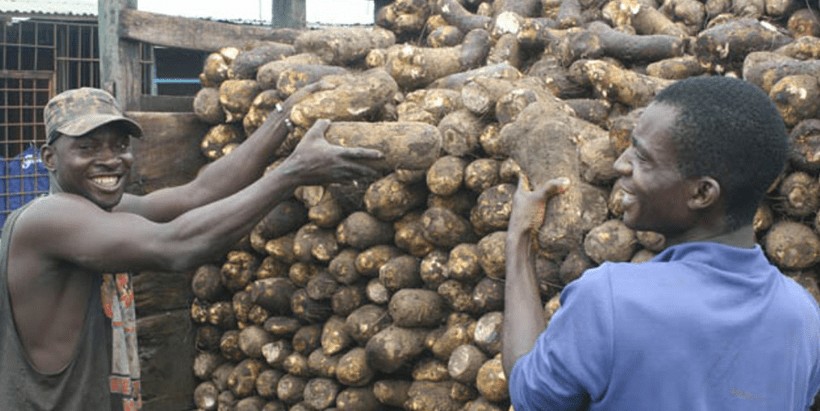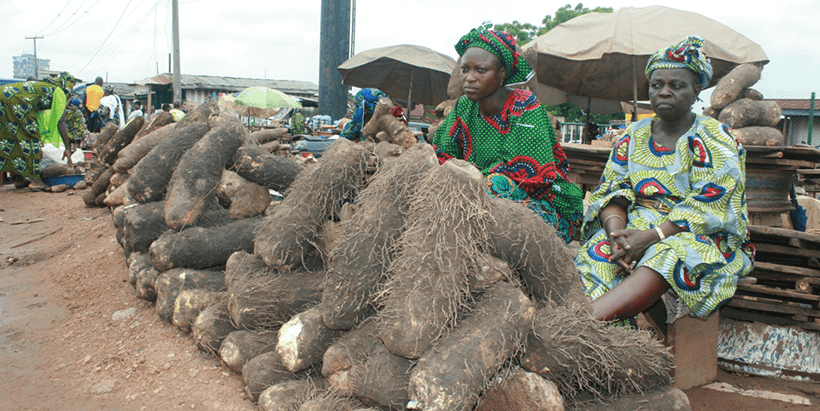Researchers identify adaptive traits with immense potential for yam improvement
A collaboration between scientists at IITA and 16 other institutions has contributed to tools and insights that will enable yam breeders to unlock the potential of Dioscorea alata L., also known as greater yam. These will help breeders take full advantage of the crop’s adaptability to varied environments.
Yam—genus Dioscorea—is an essential food and income source in tropical and subtropical regions of Africa, Asia, Latin America, and the Pacific, contributing more than 200 dietary calories per capita daily for around 300 million people. Yam tubers are also rich in carbohydrates and protein and contain vitamin C. Yam is available year-round because of their high postharvest shelf-life, making it a critical crop cultivated by African farmers.

Despite its significance for millions of people globally, the greater yam remains an orphan crop, receiving marginal commercial and research attention. The greater yam has a high potential for increased yield and broader cultivation, with advantages over other root tuber-banana crops due to its superior nutritious content and low glycemic index. Moreover, its ability to grow in tropical and sub-temperate regions suggests that it is highly adaptable to its environment.
A study conducted by 30 researchers from 17 institutions indicates that there may be adaptive traits that could be exploited in different global contexts. The greater yam establishes itself vigorously, produces higher yields than other domesticated yam species, and better tolerates marginal, poor soil and drought conditions. These traits suggest a high nutrient-use efficiency.
The study, which addressed resource gaps by presenting a highly contiguous chromosome-scale genome assembly of greater yam combined with a dense genetic map derived from African breeding populations, shows that these traits will be valuable in combating climate change. The researchers also studied genes for resistance to anthracnose, a damaging fungal pathogen of yam, and other tuber quality traits, such as extensive inbreeding.

A significant hurdle for breeders is the difficulty of making successful crosses in D. alata due to lack of flowering, limited seed set, and differences in flowering time. The genome sequence and associated resources will facilitate future marker-assisted breeding efforts for greater yam, and the genome-enabled methods will allow breeders to make the most out of each cross and use fewer resources to maintain genotypes that are less likely to be useful.
Over 90% of global yam production comes from West Africa’s “yam belt”—Benin, Côte d’Ivoire, Ghana, Nigeria, and Togo—where yam’s importance is demonstrated by its vital role in traditional culture and religion. To meet the demands of an ever-growing population and tackle the threats that constrain yam production, the rapid development of improved yam varieties is urgently needed. But conventional breeding for desired traits in greater yam is arduous.
The study used genomic and genetic resources to identify nine quantitative trait locus (QTL) for anthracnose resistance and tuber quality traits. Greater yam is highly tolerant of the most significant yam virus, yam mosaic virus. By leveraging QTL and genome-wide association for disease resistance and tuber quality, as well as marker-aided breeding strategies and genome editing, yam breeders aim to rapidly generate disease-resistant, high-performing, climate-resilient varieties of greater yam, preferred by either or both farmer and consumer.
The study, Chromosome evolution and the genetic basis of agronomically important traits in greater yam, was published in the Nature Communications open access journal. The tools and resources highlighted will empower breeders to use modern genetic tools and methods for breeding the yam more efficiently, thereby accelerating the release of improved varieties to farmers.
IITA researchers collaborated with others from the University of Copenhagen, Denmark; International Trade Center, Ghana; University of California, USA; Innovative Genomics Institute, USA; National Root Crops Research Institute (NRCRI), Nigeria; Institute of Experimental Botany of the Czech Academy of Sciences, Centre of the Region Haná for Biotechnological and Agricultural Research, Czech Republic; School of Life Sciences, University of Dundee, United Kingdom; DOE Joint Genome Institute, USA; World Agroforestry (CIFOR-ICRAF), Kenya; African Orphan Crops Consortium, Kenya; Cornell University, USA; Agricultural Research Council, Biotechnology Platform, South Africa; James Hutton Institute, UK; University of California, USA; Okinawa Institute of Science and Technology, Japan; and the Chan-Zuckerberg BioHub, USA.
Contributed by Timilehin Osunde



